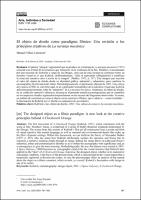Por favor, use este identificador para citar o enlazar este ítem:
https://repositorio.usj.es/handle/123456789/489
Registro completo de metadatos
| Campo DC | Valor | Lengua/Idioma |
|---|---|---|
| dc.contributor.author | Viñas Limonchi, Manuel | - |
| dc.date.accessioned | 2021-02-19T15:12:47Z | - |
| dc.date.available | 2021-02-19T15:12:47Z | - |
| dc.date.issued | 2021-01-07 | - |
| dc.identifier.citation | Viñas-Limonchi, M. (2021) El objeto de diseño como paradigma fílmico: Una revisión a los principios creativos de La naranja mecánica. Arte, Individuo y Sociedad 33(1), 161-182. | es_ES |
| dc.identifier.issn | 11315598 | es_ES |
| dc.identifier.uri | https://repositorio.usj.es/handle/123456789/489 | - |
| dc.description | The first movement of A Clockwork Orange (Kubrick, 1971), which culminates with the scene at Mrs. Weathers’ house, is comprised of a string of highly theatrical misdeeds perpetuated by the Droogs. The scenes from this portion of Kubrick’s film are all constructed from a script and form of visual narrative that exploit language as well as material and environmental details that make up the film’s dramatic settings. Within this framework, we can build on the theory of Alexander Walker (1975, p. 257), who has noted how Kubrick deliberately isolates the spectator and forces him to construct a narrative meaning simply through an image. Indeed, the image draws on a physical object’s industrial, urban and communicative identity so as to imbue the scenography with significance and, as a consequence, to give the story meaning. Methodologically, the way that objects were treated in 2001: A Space Odyssey (1968) becomes an iconographic catalyst for the visual narrative that Kubrick later applied on the "skin" of A Clockwork Orange. Likewise, the designed object, whether in its material or conceptual condition, is the focus of the present study, which is materialized in the visual impact that is temporally registered in the relevant scenes. In sum, the present paper offers an analysis of the content about the object as a filmic construct, which reveals, as a result, Kubrick’s fascination with design in any of its orders. | es_ES |
| dc.description.abstract | El primer "pliegue" argumental que se produce en el metraje de La naranja mecánica (1971) coincide con el final de la secuencia que transcurre en la residencia de la Sra. Weathers. Concatenadas por una sucesión de fechorías a cargo de los Drugos, cada una de esas escenas se construye sobre un dominio visual en el que Kubrick, deliberadamente, "aísla al espectador [obligándolo] a establecer la conexión narrativa solo a través de la imagen" (Walker, 1975, p. 257). Una imagen que suscribe el valor del objeto de diseño desde su identidad gráfica, industrial y urbanística, para confortar la escenografía y la relevancia del relato. Metodológicamente, el patrimonio objetual de 2001: Una odisea del espacio (1968) se convierte aquí en un catalizador iconográfico de la narrativa visual que Kubrick aplicaría posteriormente sobre la "epidermis" de La naranja mecánica. Asimismo, el objeto de diseño, en su condición material o abstracta, alcanza en el presente estudio un protagonismo que se cuantifica en los impactos visuales registrados temporalmente en las escenas del fragmento intervenido. En suma, un análisis de contenido en torno al objeto como constructo fílmico, que evidencia —como resultado— la fascinación de Kubrick por el diseño en cualquiera de sus órdenes. | es_ES |
| dc.format.extent | 22 p. | es_ES |
| dc.format.mimetype | application/pdf | es_ES |
| dc.language.iso | spa | es_ES |
| dc.publisher | Universidad Compultense Madrid | es_ES |
| dc.relation.requires | Requiere Adobe PDF | es_ES |
| dc.rights | Atribución 4.0 Internacional | * |
| dc.rights.uri | http://creativecommons.org/licenses/by/4.0/ | * |
| dc.subject | Kubrick | es_ES |
| dc.subject | Cine | es_ES |
| dc.subject | Objeto de diseño | es_ES |
| dc.subject | 2001: Una odisea de espacio; | es_ES |
| dc.subject | La naranja mecánica | es_ES |
| dc.subject | Cinematography | es_ES |
| dc.subject | Design object | es_ES |
| dc.subject | 2001: A Space Odyssey | es_ES |
| dc.subject | A Clockwork Orange | es_ES |
| dc.title | El objeto de diseño como paradigma fílmico: Una revisión a los principios creativos de La naranja mecánica | es_ES |
| dc.type | journal article | es_ES |
| dc.identifier.doi | 10.5209/ARIS.67612 | es_ES |
| dc.rights.accessRights | open access | es_ES |
| Aparece en las colecciones: | Artículos de revistas | |
Ficheros en este ítem:
| Fichero | Descripción | Tamaño | Formato | |
|---|---|---|---|---|
| El objeto de diseño como paradigma fílmico.pdf | 4,09 MB | Adobe PDF |  Visualizar/Abrir |
Este ítem está sujeto a una licencia Creative Commons Licencia Creative Commons

